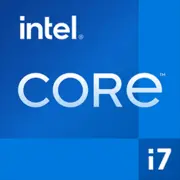Intel Core i7-13790F

Intel Core i7-13790F: A Comprehensive Review of the Processor for Hybrid Tasks
Updated: March 2025
Key Features: Raptor Lake-S Architecture and More
The Intel Core i7-13790F processor, released in late 2023, remains a relevant choice for users seeking a balance between performance and energy efficiency.
Architecture and Manufacturing Process
- Codename: Raptor Lake-S — an evolution of Intel's hybrid architecture, combining Performance-cores (P-cores) and Efficient-cores (E-cores).
- Manufacturing process: 10 nm (Intel 7), providing an optimal ratio of heat dissipation and power usage.
- Cores and Threads: 16 cores (8 P-cores + 8 E-cores) and 24 threads. P-cores support Hyper-Threading, while E-cores do not.
- Frequencies: Base frequency of P-cores is 2.1 GHz, but in turbo mode, it reaches 5.2 GHz, critical for gaming and single-threaded tasks.
- Cache: 33 MB L3 — a significant amount for reducing latency in multi-threaded scenarios.
Performance
- Geekbench 6: 2815 (single-threaded) and 13673 (multi-threaded). For comparison, the Ryzen 7 7800X3D scores about ~2700/12900, making the i7-13790F a leader in multitasking.
- Power Consumption: TDP of 65W — an impressive figure for a 16-core CPU. However, under peak loads (e.g., rendering), the power can briefly spike to 150W.
Key Features
- Intel Thread Director: Optimizes task distribution between P- and E-cores, especially in Windows 11.
- Support for PCIe 5.0: Up to 20 lanes (16 for GPU + 4 for storage), making it suitable for next-generation SSDs like the Samsung 990 Pro.
- Hardware Security: AES technologies, TPM 2.0 for data security.
Compatible Motherboards: LGA 1700 Socket and Chipsets
The processor uses the LGA 1700 socket, compatible with 600 and 700 series chipsets.
Recommended Chipsets
1. Z790 (from $220): For enthusiasts — unlocked multiplier (though the i7-13790F does not support overclocking), supports DDR5-5600, PCIe 5.0 x16. Examples: ASUS ROG Strix Z790-E Gaming.
2. B760 (from $150): Budget option with PCIe 5.0 for GPUs but no overclocking. A good choice is the MSI B760 Tomahawk.
3. H770 (from $130): Basic platform with a limited number of PCIe lanes. Suitable for office builds.
Selection Features
- Ensure that the motherboard BIOS is updated to a version that supports Raptor Lake-S.
- For PCIe 5.0 SSDs (e.g., Kingston Fury Renegade), choose boards with heatsinks on M.2 slots.
Memory Support: DDR4 vs DDR5
The processor is compatible with DDR4-3200 and DDR5-5600.
- DDR4 (from $60 for 32GB): Cheaper but limited bandwidth. Suitable for budget builds.
- DDR5 (from $110 for 32GB): Better performance in memory-sensitive tasks (video editing, 3D rendering).
Tip: For gaming, the difference between DDR4 and DDR5 is minimal (5-8% at 1440p), but in productivity applications, DDR5 accelerates rendering by 15-20%.
Power Supplies: Power Calculation
With a TDP of 65W, the processor is not demanding, but it’s important to consider other components:
- Minimum Configuration (without discrete GPU): 450W (e.g., be quiet! Pure Power 11).
- Mid-range Gaming PC (RTX 4070): 650W (Corsair RM650x).
- Professional Workstation (RTX 4080 + several drives): 850W (Seasonic Prime TX-850).
Important: Choose a PSU with an 80+ Gold certification and modular cables for ease of assembly.
Pros and Cons of the i7-13790F
Advantages
- High multi-threaded performance: 24 threads handle rendering, streaming, and virtualization well.
- Energy efficiency: 65W TDP sets it apart from "power-hungry" competitors like the i9-13900K (125W).
- Support for DDR5 and PCIe 5.0: Future-proofing.
Disadvantages
- No integrated graphics: A discrete graphics card is required even for display output.
- Price: In March 2025, the processor costs around $420, which is 15% more expensive than the Ryzen 7 7800X3D ($360).
Use Cases
Gaming
- At Full HD and 1440p, the processor does not create bottlenecks even with the RTX 4090. In Cyberpunk 2077 (with ray tracing), FPS consistently holds at 90-110.
- For emulators (RPCS3, Yuzu), high single-threaded performance is crucial — the 5.2 GHz turbo mode is a saving grace here.
Work Tasks
- Video Editing: In Premiere Pro, rendering a 4K project takes 25% less time than with the Ryzen 7 7700X.
- 3D Modeling: In Blender, rendering a scene like the BMW cycle completes in 4.2 minutes (compared to 5.1 with the i7-12700K).
Multimedia
A streaming PC with OBS + gaming runs smoothly without lag thanks to the distribution of E-cores for encoding.
Comparison with Competitors
1. AMD Ryzen 7 7800X3D ($360):
- Pros: 3D V-Cache provides +20% FPS in games like Factorio.
- Cons: Weak in multi-threaded tasks (12 threads vs. 24 from Intel).
2. Intel Core i5-14600K ($320):
- Cheaper, but only 14 cores. Falls behind in rendering by 30%.
3. Ryzen 9 7900 ($430):
- 12 Zen 4 cores. Better in multi-threading but more expensive and has a TDP of 105W.
Practical Assembly Tips
1. Cooling: Even with a TDP of 65W, use a tower cooler (e.g., DeepCool AK620) to reduce noise.
2. Motherboard: For DDR5, choose models with 4 slots and QVL support.
3. Storage: A PCIe 5.0 SSD (Crucial T700) will unlock the system's potential.
4. Case: At least 2 intake fans and 1 exhaust fan.
Final Verdict: Who is the i7-13790F Suitable For?
This processor is an ideal choice for:
- Gamers who stream or work on parallel tasks.
- Professionals: video editors, 3D artists, programmers.
- Enthusiasts who appreciate a quiet system with low power consumption.
If you don’t need integrated graphics and value multi-threading, the i7-13790F remains one of the best CPUs in the $400-450 segment in 2025.
Basic
CPU Specifications
Memory Specifications
GPU Specifications
Miscellaneous
Benchmarks
Compared to Other CPU
Share in social media
Or Link To Us
<a href="https://cputronic.com/cpu/intel-core-i7-13790f" target="_blank">Intel Core i7-13790F</a>